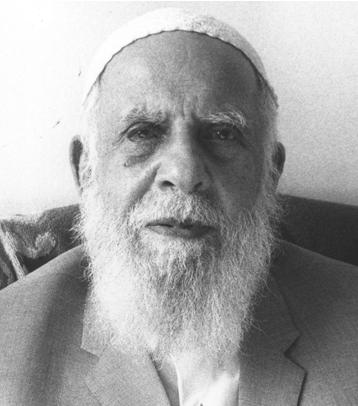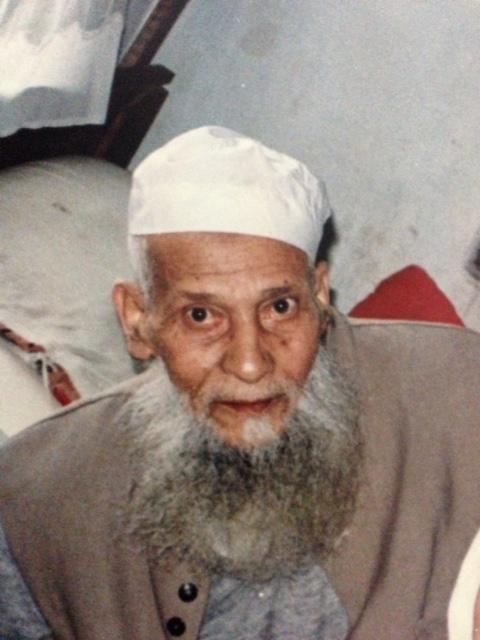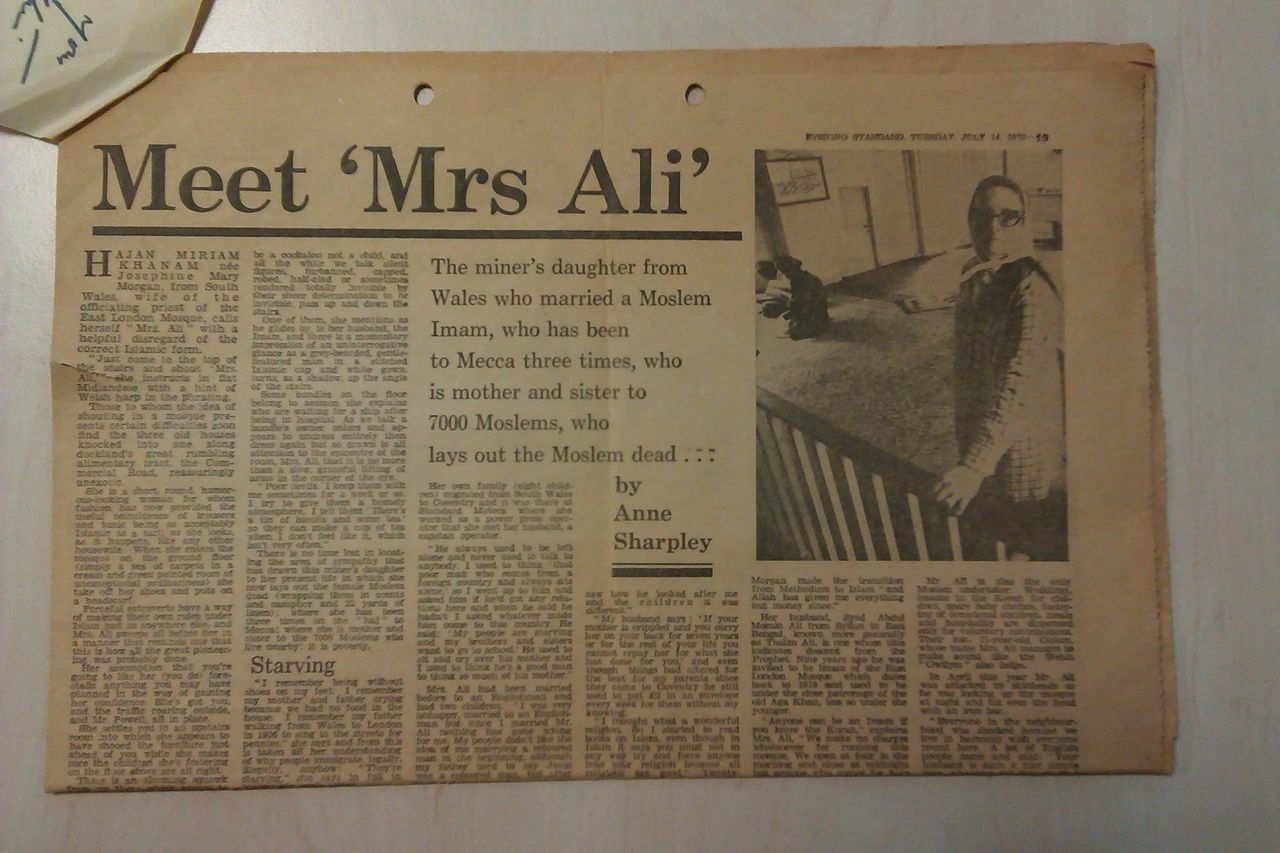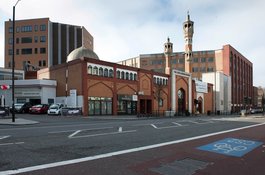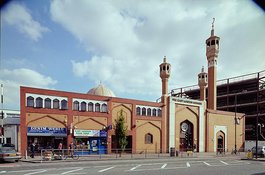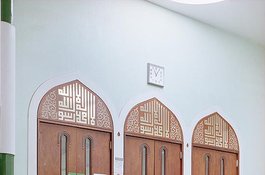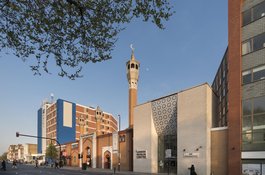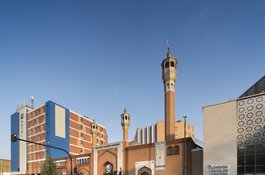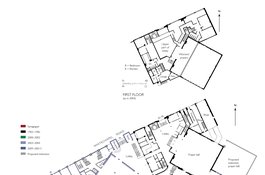Mahera Ruby's childhood memories of how the East London Mosque started
Contributed by Survey of London on March 9, 2018
Mahera Ruby, an academic and community activist, grew up in Whitechapel. Here she recalls the East London Mosque when it was a temporary building on Fieldgate Street in the late 1970s, and the opening of the new mosque in 1985.
'My dad [Maulana Abdul Awal] was an academic when he was back in Bangladesh, he was a lecturer at one of the private college universities in Comilla, and then he moved to Dhaka University. When he came here, he came as a Minister of Religion. Now that’s what I remember on the applications, whenever we had to write applications. I assume that’s an Imam’s role.
When we came to join him [around 1975/6], he [was in] east London. He was Chair of East London Mosque… he was Chair for a very long time. At that time, it was a Portakabin, so there was just this grey Portakabin on Fieldgate Street. And we used to come along with him because we were just children and we used to play in the little yard that was in front of the Portakabin.
I remember the feelings around the place. It was very warm, this is where we came [with my dad] for meetings at the mosque. But a lot of the meetings used to happen in our houses, so there’d be a few houses where the core meetings would take place. But because of the [larger] space here it was [used] more for prayer, [and] he would come to meet other uncles. So it was a lot of the older generation.
Although children were around, we weren’t very welcome [laughs] – we made a lot of noise and we would play. And I don’t remember seeing many girls but my dad particularly used to bring us. We didn’t come to the mosque for the madrasah (Islamic teaching) side, we were taught at home. We used to come for the social aspect, I guess, and it was a very formative part of my life actually because I used to see them [the older generation] in meetings, I used to be quite observant about the way they used to conduct meetings, and all the uncles around. So it was the social etiquettes, I think, I learned through that period.
I was about 8 or 9. And there was all the uncles greeting us because I was the Chairman’s daughter. It was just different. Some of those uncles I got to know then are still my mentors to this day, I still go to them for advice and they’re very much interested in what I do and how I move forward and progress. So they are anchors in my life, and similarly with my siblings as well. It’s a very close-knit community. We still work together in the community, we do a lot of stuff in the community. But it was my dad’s generation who built the foundation.
Racism
We used to have people come over from South Asia, particularly Bangladesh, who used to give large sermons. It wouldn’t fit in the Portakabin, so they used to set it up outside, so they used to lay down the mats and people used to sit there, or there’d be chairs. I was a bit tomboy-ish, I guess, so I would sit at the front with them and listen to the sermon.
There was a lot of racism around at the time, where we lived there was a lot, so there were dogs, there were skinheads, there was a lot of – my brothers were beaten up a few times. Doing nothing, just going up a lift to where we lived. In Stepney.
There’d always be young lads downstairs or they’d urinate on the stairs just outside our house knowing that we were Asian. There was a lot of that pressure, and I think we used to be brought here by my dad as relief, kind of a feeling [of] home and seeing familiar faces..… And they used to say well done, you’re doing really great, carry on what you’re doing. So we used to get our spiritual upliftment, I guess, from coming to the mosque here.
Our generation were very very few in number. So it was my brother’s generation who are 10/15 years older than me, we used to look up them because they were our guardians. We had two generations of people, I guess, that were kind of moulding us and advising us…before ’85.
And then we heard the wonderful news about the [planning permission for the new] mosque…Everybody was quite apprehensive that the project was so large, [did] we have the people who would use the mosque, and it’s going to cost so much, can we afford to do it? And it was one brave uncle who said “no, no, of course we can do it, our people will help us”. And then they turned to the community, obviously everybody was like “yes, of course”, were all behind it.
Families
But I think by that time the community might have grown a bit, and families were beginning to join because I remember at the time evening Arabic classes were happening in homes, so one used to happen in our house, my mum used to teach the children in our house.
[Our mum] was very involved in the community, one of the ways to get to the parents was through the children. The parents were quite resistant to anything organised, they were quite anxious about who and where and why, but when it came to children learning the Qur’an, it was okay. And through that medium, she got to know the parents. And I think that’s when, kind of, the community work started among families, and religious instruction. Mum would hold circles for women, and to be honest I think that’s when maybe the women’s groups kind of started as well. So gatherings of women to talk about Qur’an. It used to happen in houses, and I remember… I think Bromley-by-Bow Mosque might have been there but it was in a flat, a converted flat.
She used to walk us from Stepney all the way to Bromley-by-Bow, and there, me, my sister… three or five of us behind her, and when we used to get to the mosque she used to speak to the women and she used to give us ‘Islam: Basic Beliefs and Teachings’, [by] Gulam Sarwar. She used to give us that book and she used to say to me and my sister “you’re the teachers, this is your class”. She didn’t speak a word of English or read… “so you’re going to do that chapter by chapter, answer the questions, and then you’ll mark them because you two are the teachers”. So we used to do that and they used to get on with the women’s circles kind of things.
Concern about the future of the new mosque
And then the mosque was built. I can’t remember how long it took. But we remember coming and going. I remember the launch of it. I remember very long meetings taking place and there was a lot of anxiety, a lot of worry, who would carry this forward, they were quite elderly. They were quite worried if the next generation would carry on the dream. I remember there being lots and lots of late night meetings [in our houses] and we were constantly making tea.
[They were worried about] finances, but also they were quite worried about divisions within the community as well, so they didn’t want it to be a one community mosque. Their dream was that this would be a community mosque, there won’t be any factions, even though it may be run by one particular group of people, it’s open to all.
I remember my dad being very very conscious of that, and saying that we don’t want to be labelled as another Bangladeshi mosque, we are serving the community and we want this to be a unifying factor for the community to come. And the other thing they were thinking about was travellers. So people travelling through would have somewhere to stop and pray, so that welcoming factor as well.
I remember some of those discussions, you know, listening to them discussing those things [was] really interesting because it shaped our outlook. So rather than being navel-gazing and looking at our own community, whatever we did we actually thought about the wider community in the work that we did.
So that was really interesting because they also mentored my brother’s generation because they used to sit in on the meetings. And there was, [after the mosque was built] a situation where there was division in the Committee. And then the Committee that was here, they kind of put it out to the young people, it’s up to you guys, what do you think? Because I think it did become quite culturally divided depending on which village you came from in Bangladesh. And as far as I can remember about my dad, he wasn’t interested in that, that was the last thing that they wanted. So they put it out to the young people who were majority from that faction of people, and the young people said “no, we don’t want that, we came with a wider vision and we want this mosque”. So there was the splintering off [of] a smaller group [and] the majority stayed here, but I think there was a bit of tussle.
So it survived, and we continued. Then I have this gap in memory, so I don’t quite remember, and then I just remember LMC [London Muslim Centre] being built
The opening of the East London Mosque
[When the East London Mosque was built in 1985] I just remember a lot of excitement. I remember the first opening prayer. It was huge. There were lots and lots and lots of people, there was a lot of excitement, lot of, I think, pride. There was a lot of pride, they’d achieved this as a community and they didn’t have to turn to government money for this so it’s kind of [an] independent voice. And I remember Central Mosque being really supportive – you know, Regent’s Park Mosque - although that one’s big, there was more warmth and use here, as a community, the community spirit. We used to go there quite a lot, Central Mosque, because that was the only other big mosque to go to.
I just remember it [the ELM] looking really big. I must have been quite small! [laughs] And I just remember a lot of the uncles, you know they go around, just sort of tapping, feeling, is it for real? I don’t know, there was just a lot of – they were holding each other. It was quite emotional, I think, for them as well.
The mosque caretaker
We used to have a caretaker here … we used to call him Rahman chacha [uncle], that’s what we knew him as, he was the mosque. I mean, if we wanted anything, you had to be in his good books. He was quite a short stout man but he had the key – what I remember about him was his keys, so it’s this big batch of keys he used to carry. He knew the mosque inside out, the basement. To us, it was exploration. He would take us for these little tours because when the kids used to mess around, he used to take them on these little tours, and he became our favourite uncle because he used to entertain us. And if we wanted water, if we wanted anything, it was Khan chacha, that’s what we used to call him. He used to live in the mosque apartment. When my mum used to run out of insulin, we’d come to him because he had the insulin!
The mosque was a source of so much – health, wealth, everything for us as a community. And it was such a tight-knit community. They overcame so many differences. And I truly don’t know how they did that, something must have really held them together, the vision, the dream of what they wanted to see was so much greater than the little differences that they had.
Women’s prayer space in the 1985 East London Mosque
[The women’s gallery was] open [overlooking the men's prayer hall] and we made too much noise, I think, with the kids. So we used to come for tarawih [extra Ramadan prayers] and I remember the children used to try to look over [the gallery] and it wasn’t safe, then they put the glass windows in as well. And it used to be packed when we used to come for tarawih. It helped to break down so many traditional walls that we’d built in our community about women [not] coming to the mosque. And I remember the resistance from the mosque community – wider community about women coming to the mosque.
We used to be chased by certain uncles with their sticks. And then Khan chacha used to save us. So he used to – “go, go behind there” and then show us another route. So it wasn’t liked.
But the Committee were very strong [in providing space for women]. They sang from the hymn sheet. And the imams. They were very positive. And we started our circle in the library, so the heart of the mosque was given over to the girls. We used to hold our Saturday circles, we still run at the mosque, it still continues. And we used to have it at the mosque library.
I think at the time, the Committee were very open-minded, but their religious education [was mixed]. Somebody like my dad who was educated through the madrasah (Islamic schooling) but also through mainstream [school], he held a Master’s in Arabic and Islamic studies, he had the understanding of what the future could look like for us. And also this amazing uncle who was very pragmatic and very forward thinking as well. He knew that there isn’t anywhere that says that women can’t come to the mosque. Also if they needed the children to access the mosque, they needed the parents to come. And usually it’s the women that used to bring the children to the madrasah. It [the women’s prayer space] was a small space comparatively, compared to the main hall and also it overlooked the men’s hall, which probably the public didn’t expect. “Women overlooking men? They should be behind a wall”. So it was quite forward-thinking, I think, and quite brave.
And it [the women’s space] wasn’t done as a tick-box list, sort of exercise, which is different. It was actually with the intention of being used and active. And we felt that at least by the Committee, we are wanted.'
Mahera Ruby was in conversation with Nishat Alam and Shahed Saleem on the 19th January 2018 at the East London Mosque. The interview has been edited for print.
